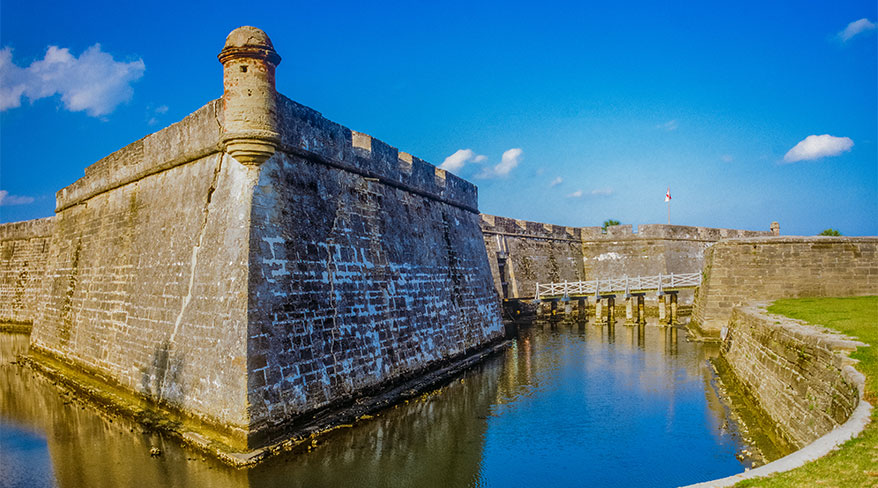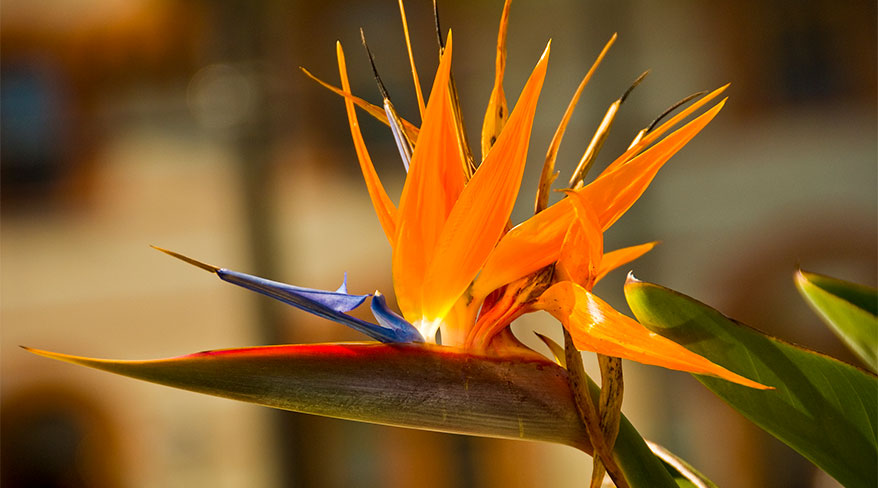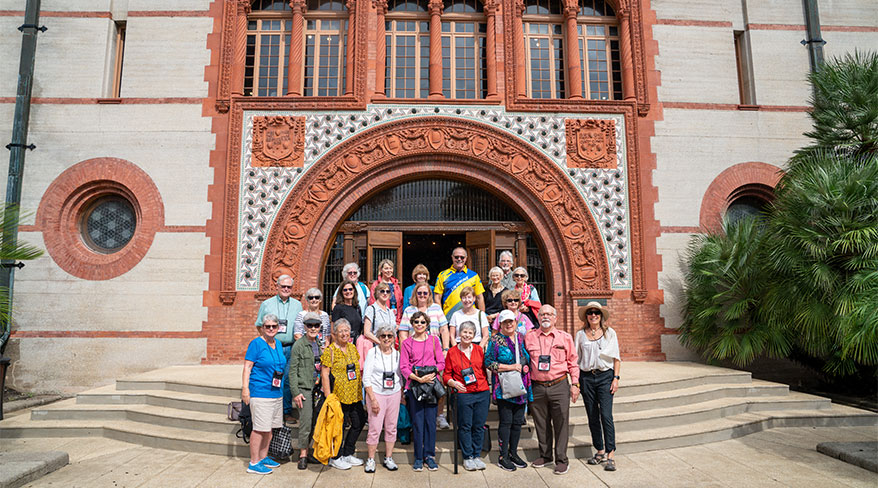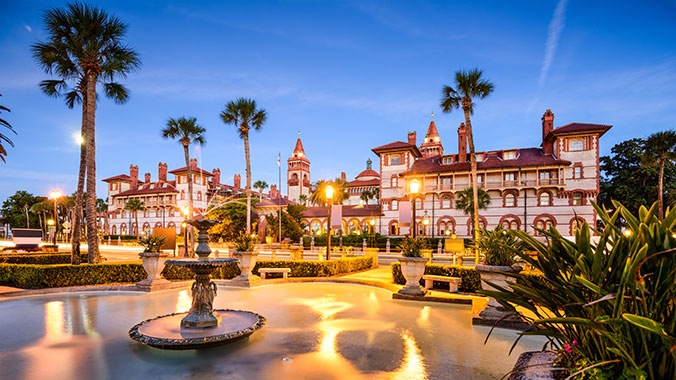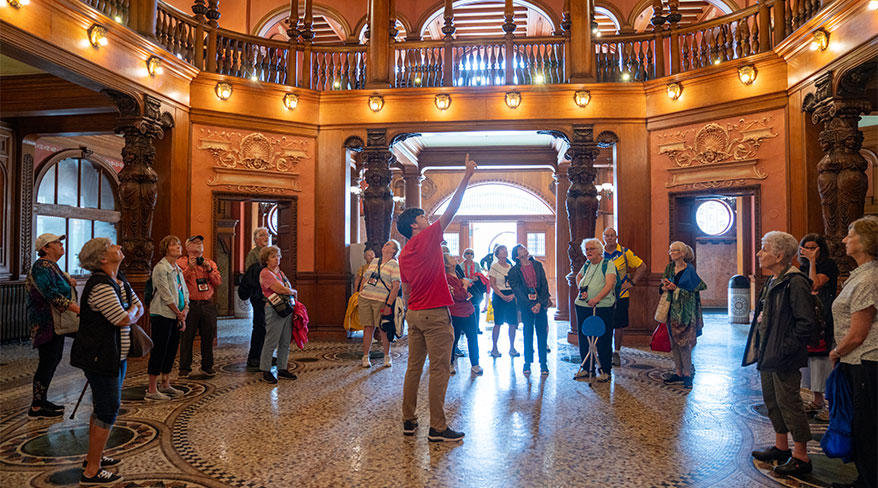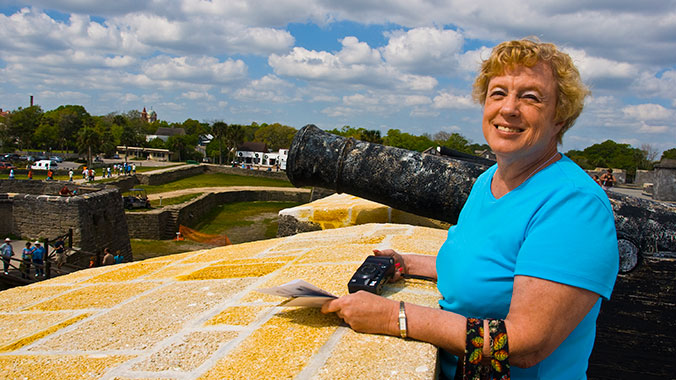Florida
Signature City St. Augustine
Program No. 6642RJ
Explore culturally vibrant St. Augustine with historians and experts to learn the story of the nation’s oldest city through its architecture, art, monuments, Gilded Age works and more.
Itinerary
While we make every effort to ensure the accuracy of our published materials, programs are typically advertised more than a year prior to their start date.
Read More.
While we make every effort to ensure the accuracy of our published materials, programs are typically advertised more than a year prior to their start date. As a result, some program activities, schedules, accommodations, personnel, and other logistics occasionally change due to local conditions or circumstances. Should a major change occur, we will make every effort to alert you. For less significant changes, we will update you during orientation. Thank you for your understanding.
Duration
6 days
5 nights
What's Included
11 meals (
5B, 3L, 3D
)
8 expert-led lectures
10 expert-led field trips
An experienced Group Leader
5 nights of accommodations
Taxes and customary gratuity
Road Scholar Assurance Plan
Day
1
Check-in, Registration, Welcome Dinner, Orientation
Location:
St. Augustine, Florida
Meals:
D
Stay:
Casa Monica Hotel
Activity Note
Program registration from 3:00 p.m.-4:00 p.m. in the meeting room with Orientation beginning at 4:00 p.m. Hotel check-in is 4:00 p.m. or later.
Afternoon:
Program Registration: After checking in to your room, come to the meeting room to register and check in with the program staff and get your welcome packet containing an up-to-date schedule that reflects any last-minute changes. Orientation starts at 4:00 p.m. sharp. If your arrival is delayed, please let your Group Leader know as soon as possible.
Dinner:
Dinner will be served at the hotel in our private room.
Evening:
Introductions and Orientation: Our Group Leader will kick off the program with introductions and a game or two so we get to know one another. Then we will review the program schedule in depth, discuss any changes, roles and responsibilities, logistics, safety guidelines, emergency procedures, and answer any questions you may have. Free time has been reserved during the week for your personal independent exploration. Evenings at leisure offer opportunities to make the program more meaningful and memorable through engaging in available activities on your own, or simply relaxing and making new friends among fellow participants. The Group Leader will always be happy to offer suggestions of additional activities or best places to shop. Please note that program activities, schedules, and personnel may need to change due to local circumstances. In the event of changes, we will alert you as quickly as possible. Thank you for your understanding. Continue getting to know your fellow Road Scholars, settle in, and get a good night’s rest for the full day ahead.
Day
2
Before the Europeans, Historic District, Architecture
Location:
St. Augustine, Florida
Meals:
B,L
Stay:
Casa Monica Hotel
Activity Note
Boarding/disembarking trolley; walking up to 2 miles, sometimes on uneven terrain; stairs (no elevator) at the Oldest House.
Breakfast:
Breakfast at the hotel.
Morning:
Following breakfast, we'll hear a presentation about the first settlers to the area, the Timucuas, who called Northeast and North Central Florida and Southeast Georgia their home. It is believed that the Timucuas may have been the first Native Americans to see the Spanish explorers when they landed in Florida. At the time of the European contact it is believed this was home to a thriving community of 200,000+ Timucuas. From 1649-1656, the population began to diminish. War with the English and other Indians decreased their numbers and a series of epidemics further diminished their population, the major one being smallpox. In fewer than 250 years the Timucuas completely disappeared. Following this lecture by renowned archaeologist, we will take a guided archaeology walk through the historic district, an exclusive experience led by our expert.
Lunch:
Our archeology walk ends at the Governor's House and then we will walk across the street to lunch.
Afternoon:
After lunch, an open-sided trolley will take us for a non-stop narrated exploration of the Historic District. In this city occupied since the 1600s, we’ll see evidence of the Spanish, British and American occupations of St. Augustine and gain insight as to how people from each period may have lived. The guided trolley ride ends at the González–Alvarez House, also known as The Oldest House, where a docent will lead a guided tour. The González–Alvarez House, is now an historic museum. With a construction history dating to about 1723, it is believed to be the oldest surviving home in St. Augustine. It is also an important example of St. Augustine's Spanish colonial architectural style, with later modifications by English owners. It was designated a U.S. National Historic Landmark in 1970 and is now owned by the St. Augustine Historical Society. Following the tour, we will be joined by the founding president of the Friends of St. Augustine Architecture Society for a presentation on St. Augustine's “vernacular” architecture: design based on local needs, materials, and traditions that span the city’s history, adapted to meet changing times.
Dinner:
Dinner on your own this evening. Your Group Leader will provide recommendations within easy walking distance of our hotel.
Evening:
At your leisure.
Day
3
The Europeans, Castillo de San Marcos, Minorcans
Location:
St. Augustine, Florida
Meals:
B,L,D
Stay:
Casa Monica Hotel
Activity Note
Walking up to 2 miles; some stairs, uneven terrain, especially at the Fort.
Breakfast:
Breakfast at the hotel.
Morning:
Begin the morning in our meeting room for an historical overview of St. Augustine's European era and the Castillo (Fort). Our presenter, a retired Interpretive National Park ranger. At the conclusion of the lecture, we’ll walk to the Castillo de San Marcos. The Castillo is a monument not only of stone and mortar but of human determination and endurance. It symbolizes the clash of cultures which ultimately resulted in our uniquely unified nation. Still resonant with the struggle of an earlier time, these walls provide tangible evidence of America’s remarkable history. Following the visit at the Castillo, we'll take a short ride to Lincolnville and the Lincolnville Museum, which tells the story of the area's African American slaves and settlers, and the important role played during the Civil Rights era.
Lunch:
Lunch will be served at the museum. We'll be treated to a homemade buffet of authentic Soul Food.
Afternoon:
After lunch, we return to Casa Monica and you'll have some free time to relax before our afternoon talk. You'll meet a fabulous author, retired college professor, city's Poet Laureate, and historical interpreter. Through her engaging recollections and poetry "in the vernacular," she weaves together the history of Floridanos, Minorcans, and Crackers.
Dinner:
We will meet in the hotel lobby and walk to a favorite local restaurant.
Evening:
At leisure.
Day
4
Maritime Museum, Lincolnville Museum, Free Time
Location:
St. Augustine, Florida
Meals:
B
Stay:
Casa Monica Hotel
Activity Note
Boarding/disembarking an enclosed bus multiple times during field trips; walking up to 2 miles; some stairs, uneven terrain.
Breakfast:
Breakfast will be at the hotel.
Morning:
We'll ride to the historic St. Augustine Lighthouse and Maritime Museum. Here we will enjoy a lecture by a nationally- renowned maritime archeologist and explore the museum. Next, we return to the hotel for a talk about the British Period by a noted historian and scholar.
Lunch:
This meal has been excluded from the program cost and is on your own to enjoy what you like. The Group Leader is happy to offer suggestions.
Afternoon:
Free Afternoon: Take this opportunity for personal independent exploration to see and do what interests you most. The Group Leader is happy to offer suggestions and give directions.
Dinner:
On your own.
Evening:
At leisure.
Day
5
The Age of Flagler: Meet Mrs. Flagler & See Flagler's Legacy
Location:
St. Augustine, Florida
Meals:
B,L,D
Stay:
Casa Monica Hotel
Activity Note
Walking up to 2 miles; some stairs (elevator may not be available at all sites), uneven terrain.
Breakfast:
Breakfast at the hotel.
Morning:
Henry M. Flagler's legacy as railroad tycoon, hotelier, and "Father of Tourism" is deeply appreciated and acknowledged in St. Augustine and the State of Florida. We will meet in the lobby and walk to the grounds of the Lightner Museum and be joined in the historic chapel by one of the first individuals to realize the potential of this titan of industry, the love of his life and first wife, Mary Harkness, in the person of our noted professional actor. Following that presentation, we will transition to the Lightner Museum, where our docent guides will share with you the museum's rich past and lead you through select galleries. The Lightner Museum is housed in the former Alcazar Hotel built in 1888 by Henry Flagler. Today it is home to one of the best collections of fine and decorative 19th century art in the country.
Lunch:
We will walk a few blocks to lunch at a local restaurant.
Afternoon:
After lunch we'll walk (approximately 3 blocks) to Memorial Presbyterian Church. Built in 1889 as a memorial to Flagler's daughter and infant granddaughter who died that year, this church is an elegant example of Venetian Renaissance architecture. Following our tour, we’ll walk a few blocks to Flagler’s magnificent Ponce de Leon Hotel that set the standard for luxury in 1888, and became the centerpiece of Flagler College in 1968. We’ll hear from an expert student leader who will share information about the first of the luxury hotels Flagler built on the east coast of Florida. Learn how the building featured innovations such as a steam heating system and electricity as well as interior stained glass designed by Louis Tiffany. We then walk back to the hotel to freshen up before dinner.
Dinner:
We'll gather in the lobby and walk to our farewell dinner at a local restaurant.
Evening:
At leisure.
Day
6
Wrap-Up, Program Concludes
Location:
St. Augustine, Florida
Meals:
B
Activity Note
Hotel check-out is by 11:00 a.m.
Breakfast:
Breakfast at the hotel.
Morning:
In the hotel meeting room, our closing session will feature a recap of the week's highlights and sharing of our most memorable experiences. This concludes our program. We hope you enjoy Road Scholar learning adventures and look forward to having you on rewarding programs in the future.
Please select a day to update the map
Map details are not available for this location.

